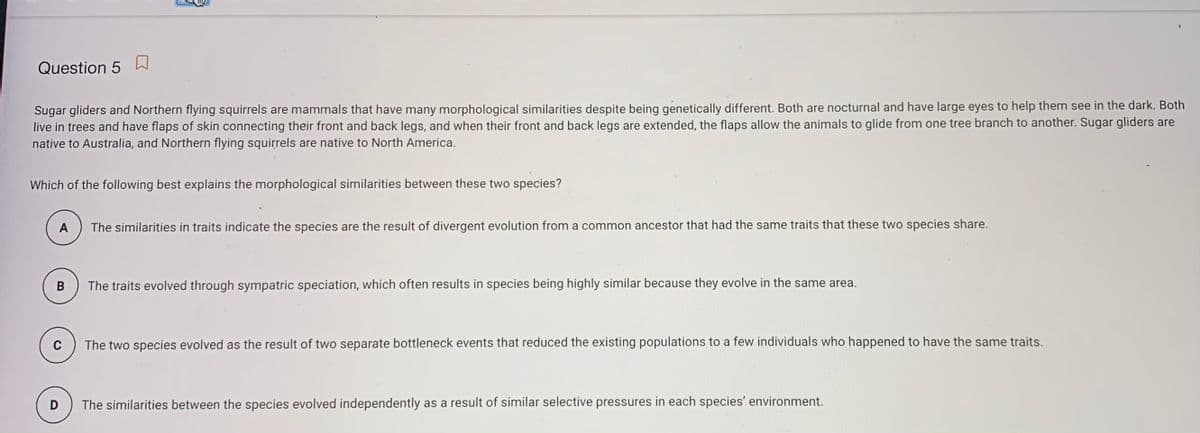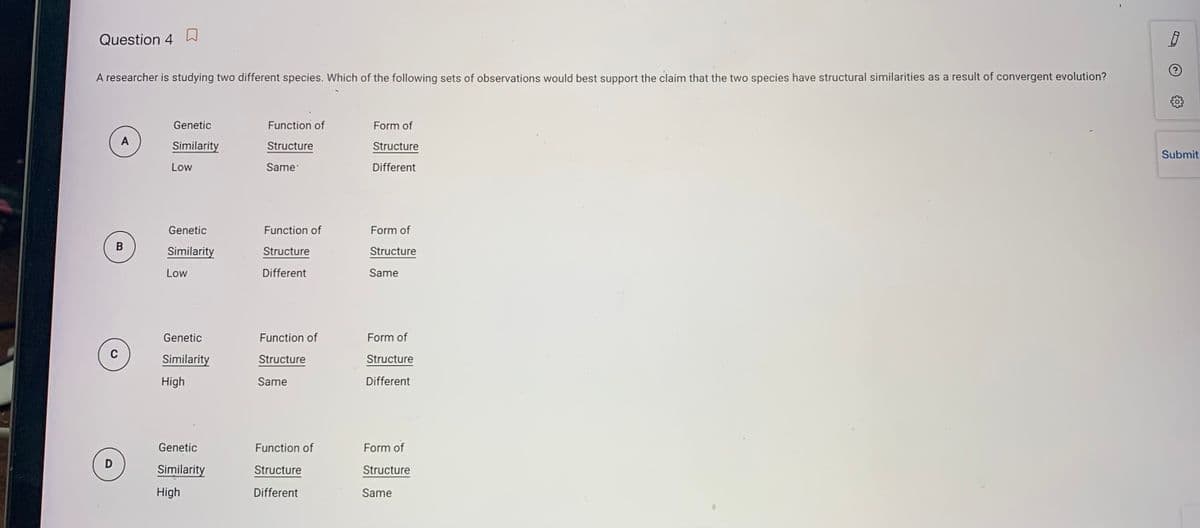Question 5 Sugar gliders and Northern flying squirrels are mammals that have many morphological similarities despite being genetically different. Both are nocturnal and have large eyes to help them see in the dark. Both live in trees and have flaps of skin connecting their front and back legs, and when their front and back legs are extended, the flaps allow the animals to glide from one tree branch to another. Sugar gliders are native to Australia, and Northern flying squirrels are native to North America. Which of the following best explains the morphological similarities between these two species? A The similarities in traits indicate the species are the result of divergent evolution from a common ancestor that had the same traits that these two species share. The traits evolved through sympatric speciation, which often results in species being highly similar because they evolve in the same area. The two species evolved as the result of two separate bottleneck events that reduced the existing populations to a few individuals who happened to have the same traits. D The similarities between the species evolved independently as a result of similar selective pressures in each species' environment.
Question 5 Sugar gliders and Northern flying squirrels are mammals that have many morphological similarities despite being genetically different. Both are nocturnal and have large eyes to help them see in the dark. Both live in trees and have flaps of skin connecting their front and back legs, and when their front and back legs are extended, the flaps allow the animals to glide from one tree branch to another. Sugar gliders are native to Australia, and Northern flying squirrels are native to North America. Which of the following best explains the morphological similarities between these two species? A The similarities in traits indicate the species are the result of divergent evolution from a common ancestor that had the same traits that these two species share. The traits evolved through sympatric speciation, which often results in species being highly similar because they evolve in the same area. The two species evolved as the result of two separate bottleneck events that reduced the existing populations to a few individuals who happened to have the same traits. D The similarities between the species evolved independently as a result of similar selective pressures in each species' environment.
Case Studies In Health Information Management
3rd Edition
ISBN:9781337676908
Author:SCHNERING
Publisher:SCHNERING
Chapter6: Leadership
Section: Chapter Questions
Problem 6.21.3C
Related questions
Question

Transcribed Image Text:Question 5 W
Sugar gliders and Northern flying squirrels are mammals that have many morphological similarities despite being genetically different. Both are nocturnal and have large eyes to help them see in the dark. Both
live in trees and have flaps of skin connecting their front and back legs, and when their front and back legs are extended, the flaps allow the animals to glide from one tree branch to another. Sugar gliders are
native to Australia, and Northern flying squirrels are native to North America.
Which of the following best explains the morphological similarities between these two species?
A
The similarities in traits indicate the species are the result of divergent evolution from a common ancestor that had the same traits that these two species share.
The traits evolved through sympatric speciation, which often results in species being highly similar because they evolve in the same area.
C
The two species evolved as the result of two separate bottleneck events that reduced the existing populations to a few individuals who happened to have the same traits.
D
The similarities between the species evolved independently as a result of similar selective pressures in each species' environment.

Transcribed Image Text:Question 4
A researcher is studying two different species. Which of the following sets of observations would best support the claim that the two species have structural similarities as a result of convergent evolution?
Genetic
Function of
Form of
A
Similarity
Structure
Structure
Submit
Low
Same
Different
Genetic
Function of
Form of
Similarity
Structure
Structure
Low
Different
Same
Genetic
Function of
Form of
Similarity
Structure
Structure
High
Same
Different
Genetic
Function of
Form of
Similarity
Structure
Structure
High
Different
Same
B.
Expert Solution
This question has been solved!
Explore an expertly crafted, step-by-step solution for a thorough understanding of key concepts.
This is a popular solution!
Trending now
This is a popular solution!
Step by step
Solved in 3 steps

Knowledge Booster
Learn more about
Need a deep-dive on the concept behind this application? Look no further. Learn more about this topic, biology and related others by exploring similar questions and additional content below.Recommended textbooks for you

Case Studies In Health Information Management
Biology
ISBN:
9781337676908
Author:
SCHNERING
Publisher:
Cengage

Case Studies In Health Information Management
Biology
ISBN:
9781337676908
Author:
SCHNERING
Publisher:
Cengage